Grazing occultation of star Aldebaran by the Moon in the day sky
May 08, 2016
| Frameless version of this page |
Occultations of star Aldebaran by the Earth Moon
Observation place Ravelsbach in Lower Austria
Results and evaluation of the recordings
Occultations of star Aldebaran by the Earth Moon
The bright star Aldebaran (alpha Tauri) in the constellation Taurus is occulted again after the year 1999 in the years 2015 to 2018 several times by the moon. And after 2018 the next Aldebaran occultation will not be observable again until 2034. In addition to the full occultation by the Earth's moon, there are several grazing occultations through the mountains and valleys along the lunar edge in the period from 2015 to 2018. These grazing events can often appear spectacular by multiple occultations within a few seconds and take place both in daytime and at nighttime.
The result of the calculation of a grazing star occultation reveals, among other things, two lines on the surface of the earth along which this graze event is observable. A line shows the course for the North Pole area of the Moon and the second shows the course for the South Pole area of the Moon. In the intervening region, a single complete covering of the star takes place through the Earth moon. This can be used to estimate whether the journey to a location on one of these lines with the necessary equipment is possible. For an observation site in Austria 2016 and 2017 a total of five grazing occultations of Aldebaran will be listed by the Earth Moon.
May 08, 2016
July 29, 2016
October 19, 2016
February 05, 2017
November 06, 2017
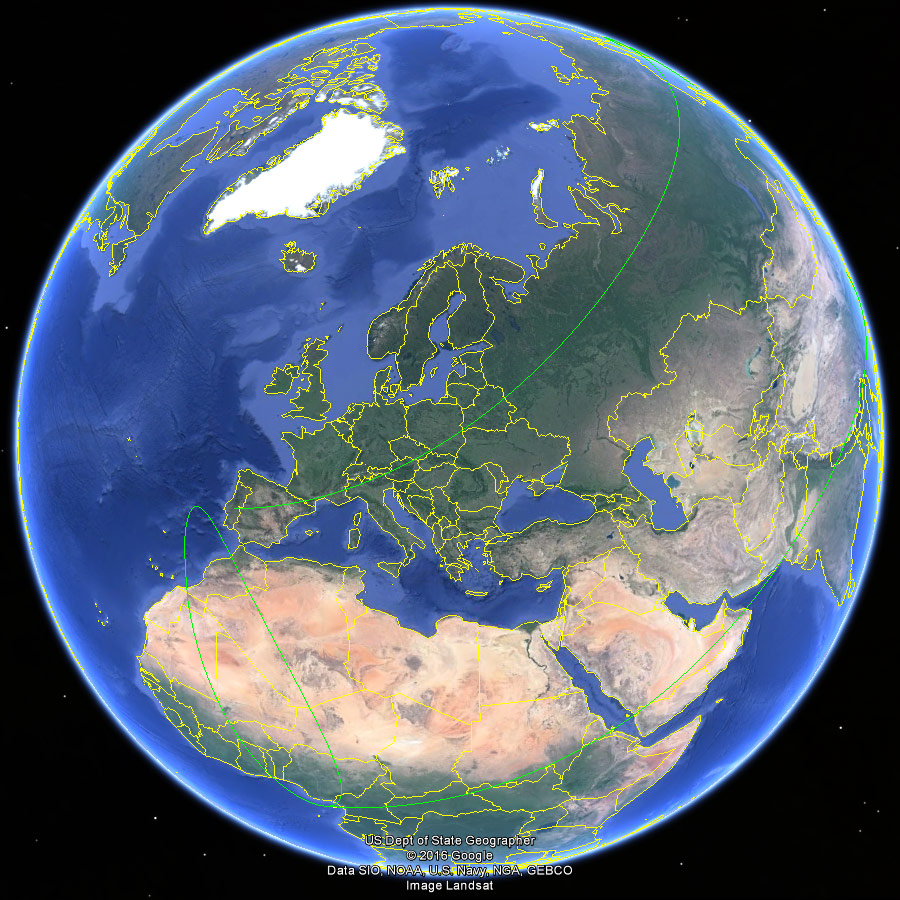
On the forenoon of the 8th of May, 2016, there was a grazing occultation of Aldebaran through the North Pole area of the Earth Moon, which was observed in Lower Austria in the southeast sky. The course of the calculated graze line crossed Austria from Salzburg to Lower Austria. The smallest distance of this line was 45 kilometers and so relatively close to my hometown 3830 Nonndorf and therefore it was decided to try this difficult observation in the day sky. A grazing occultation of Aldebaran through the southern pole of the moon could also be observed on a line from Africa to India.
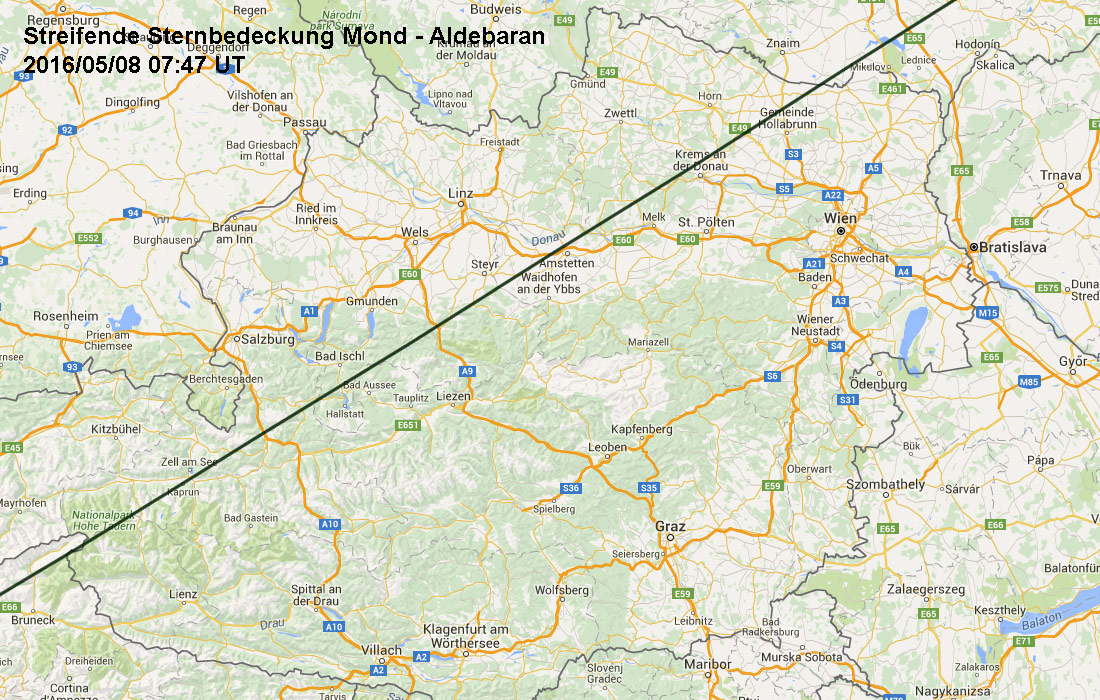
Observation place Ravelsbach in Lower Austria (15.8475 E, 48.5550 N)
The observation site is also co-determined by the choice of the moon's edge profile to be observed. For May 08, 2016, I decided to measure the moon profile at -335 meters below the mathematical lunar edge. This means that the observing site on the Earth is adapted three-dimensionally so that the star passes -335 meters below the mathematical lunar edge from the eastward moving moon and is occulted several times.
After several possible observation positions were selected on the computer, the on-site inspection then made a decision for the place in front of the waste collection center in 3720 Ravelsbach. Here on Sunday morning after a relatively short journey of about 45 minutes the setup of the equipment and the observation should be easily possible. On May 8th, 2016, some strollers and cyclists showed keen interest in the planned observation and the installed equipment. So some interesting conversations developed before the actual observation and video recording.
The observation in Ravelsbach
Therefore, the search began in the sky with the video camera WAT-902H2 Ultimate. Since the star Aldebaran transmits a large light component in the long-wave red range due to its spectral class K5 III, a planet IR Pro 807 infrared filter of astronomy was used for recording in the blue daytime sky. The relatively steep transmission curve of this filter ensures that wavelengths below about 775 nm are blocked and only longer-wavelength light components reach the CCD of the video camera. The Sony CCD EXview HAD ICX429ALL in the video camera still has a relative sensitivity of 35% at 775nm, and still reaches 10% even at 950nm. This camera is also very well suited for recording in the optical infrared. With this IR filter, the contrast of the reddish star in the blue day sky should be significantly increased. Unfortunately, the field of view of the video camera at 1200 millimeter focal length with only 18.3 x 13.7 arc minutes is very small. And the search for the star and the lighted moon edge was very time-consuming. But the reddish star Aldebaran could be discovered on the computer screen in spite of some cloud veils in time. The illuminated lunar edge, which reflects the continuum of the sun, had, however, a much smaller surface brightness than the almost point-shaped star, and therefore the narrow crescent moon could be recognized only schematically on the screen.
As telescope, the 10-inch Newton with 1200mm focal length was used. As a video camera a WAT-902H2 Ultimate CCIR was used without integration. In a filter drawer was the infrared filter Planet IR Pro 807 used. As video time Inserter - VTI a KIWI-OSD with Garmin GPS18x LVC sensor was used. The installation of Skywatcher EQ6 was controlled by EQMOD and Guide9. The video was recorded via a TIS converter via USB3.0 on the fast SSD of the notebook.
Results and evaluation of the recordings
Diagram of equipment setup on May 08, 2016
The determination of a suitable observation site is supported by a self-designed Excel calculation sheet. If it is possible, the observation site is not only determined by the computer, but also personally a few days before the observation, in order to search for an alternative observation site in case of unforeseen problems. It is often necessary to select the observation site within a tolerance band of a few meters in width in order to be able to measure the desired lunar profile. A further difficulty with the site selection results from the fact that this tolerance band is also to be displaced horizontally with a change in the sea level of the observation site on the ground. Thus, in reality, from the straight line, a jagged line displaces the higher-lying observation position to the moon and vice versa.
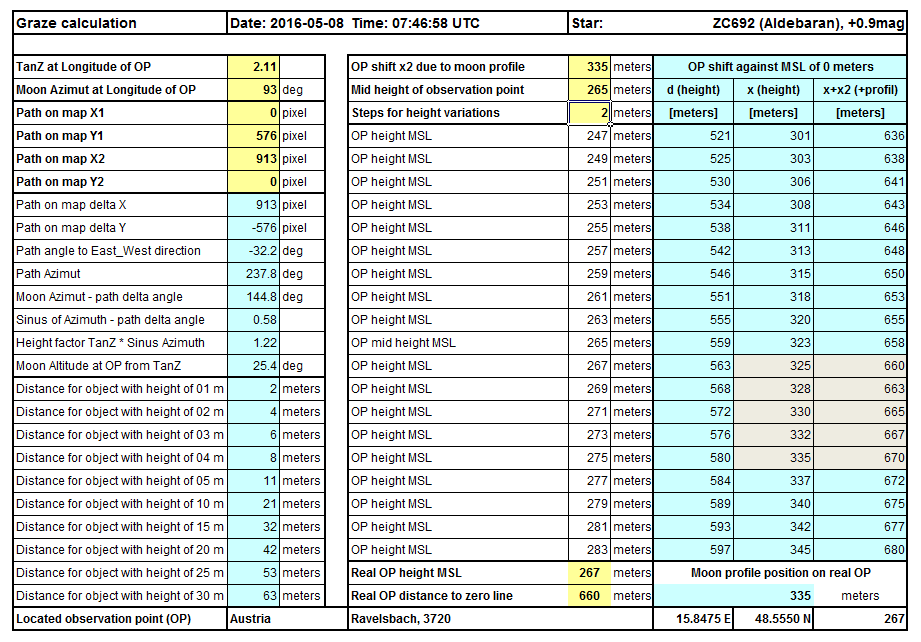
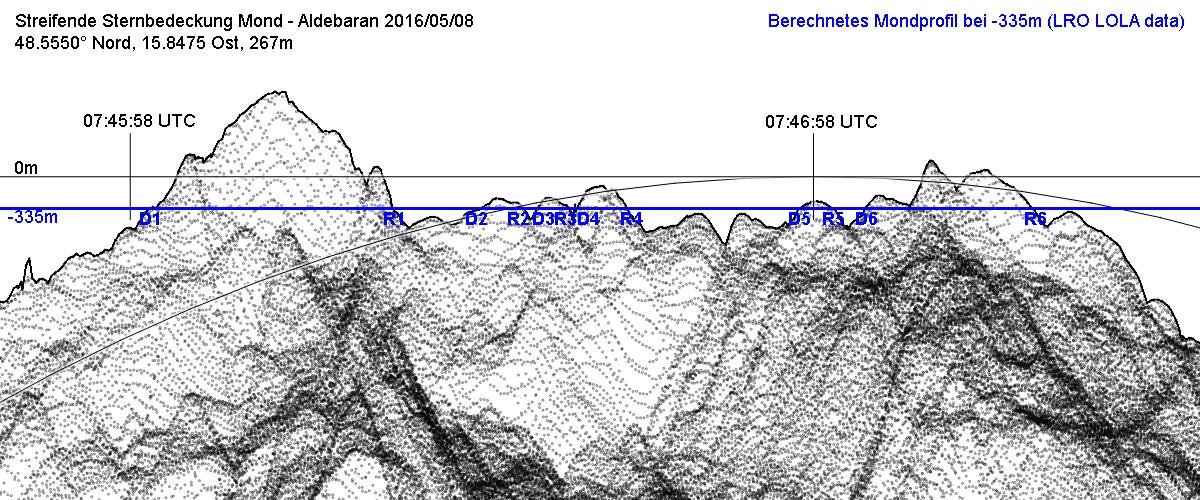
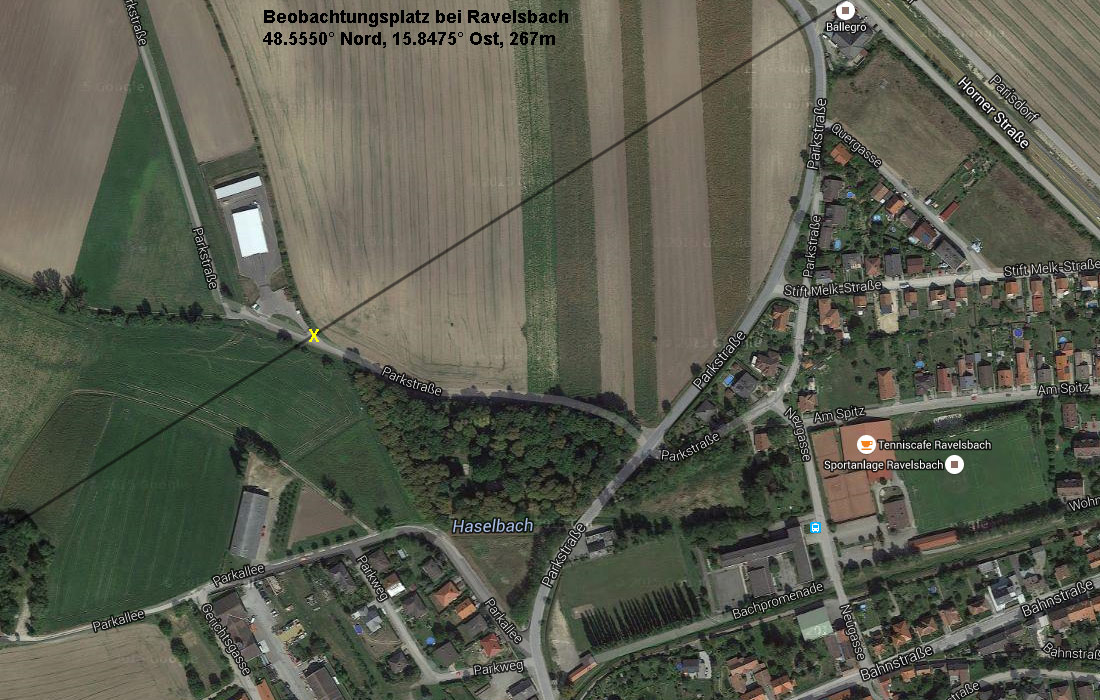
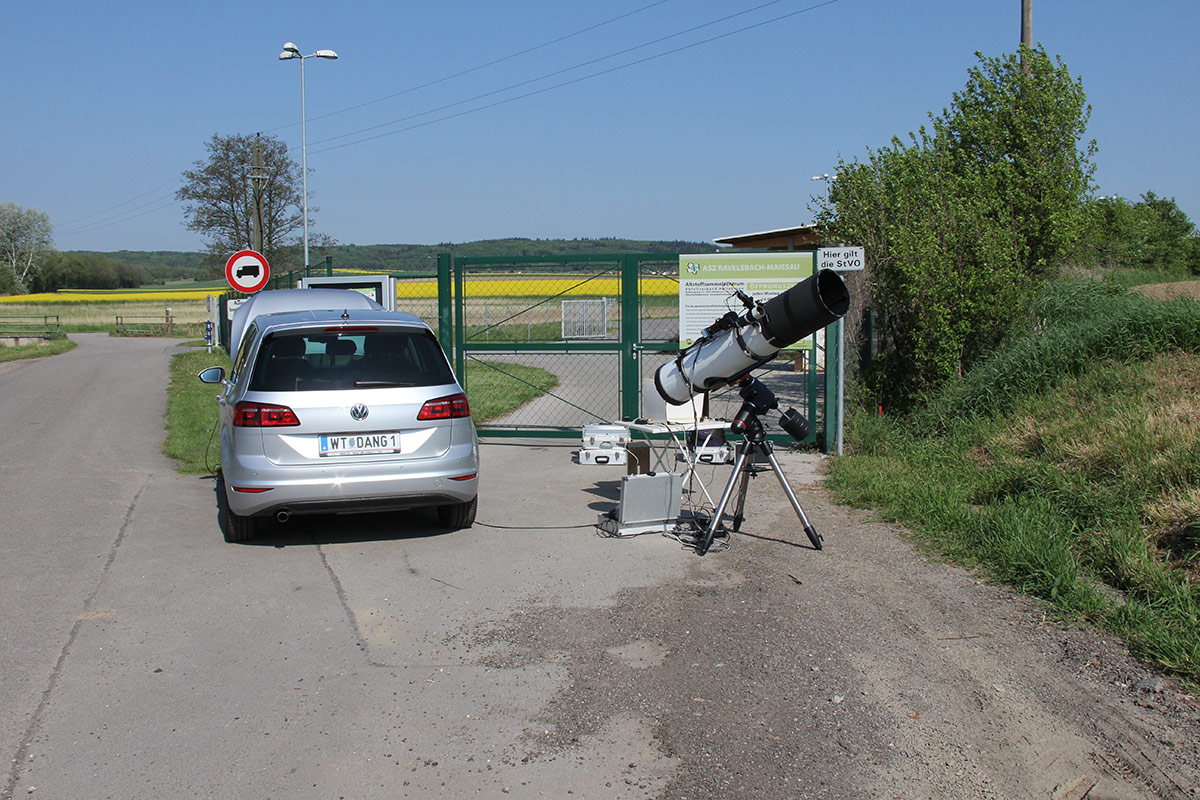
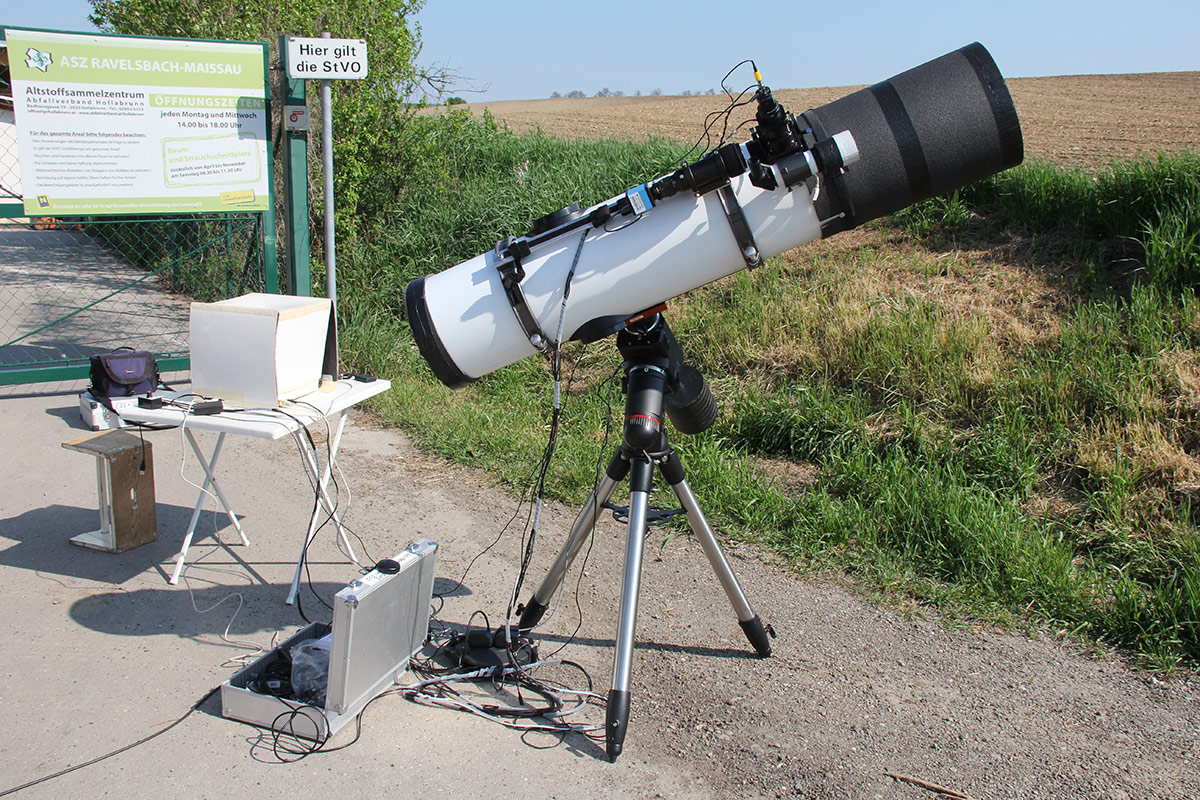
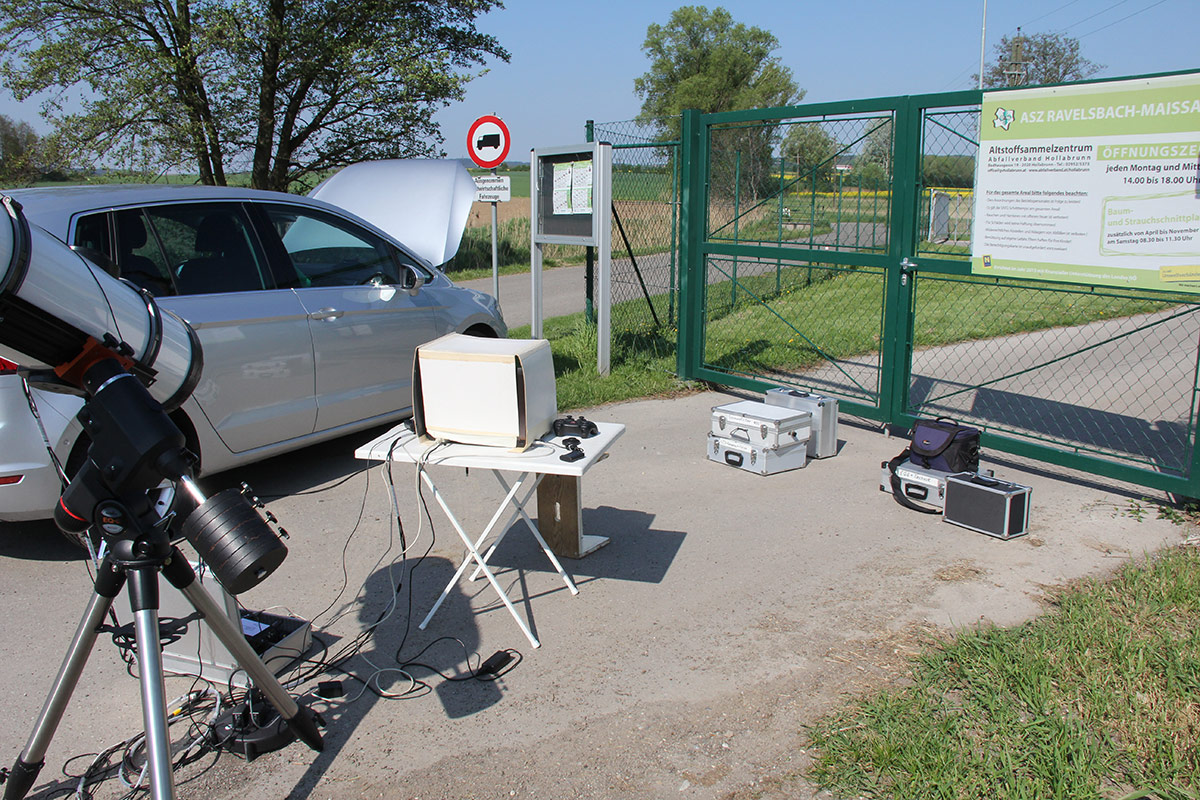
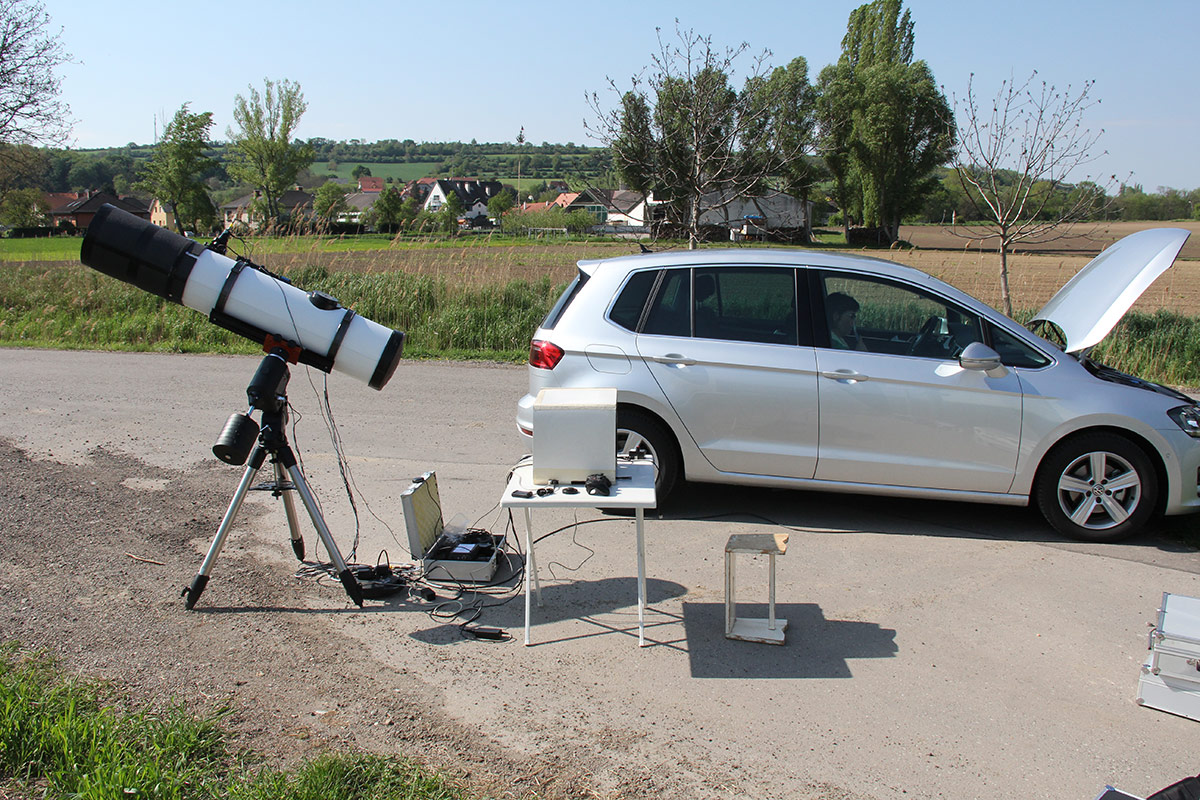

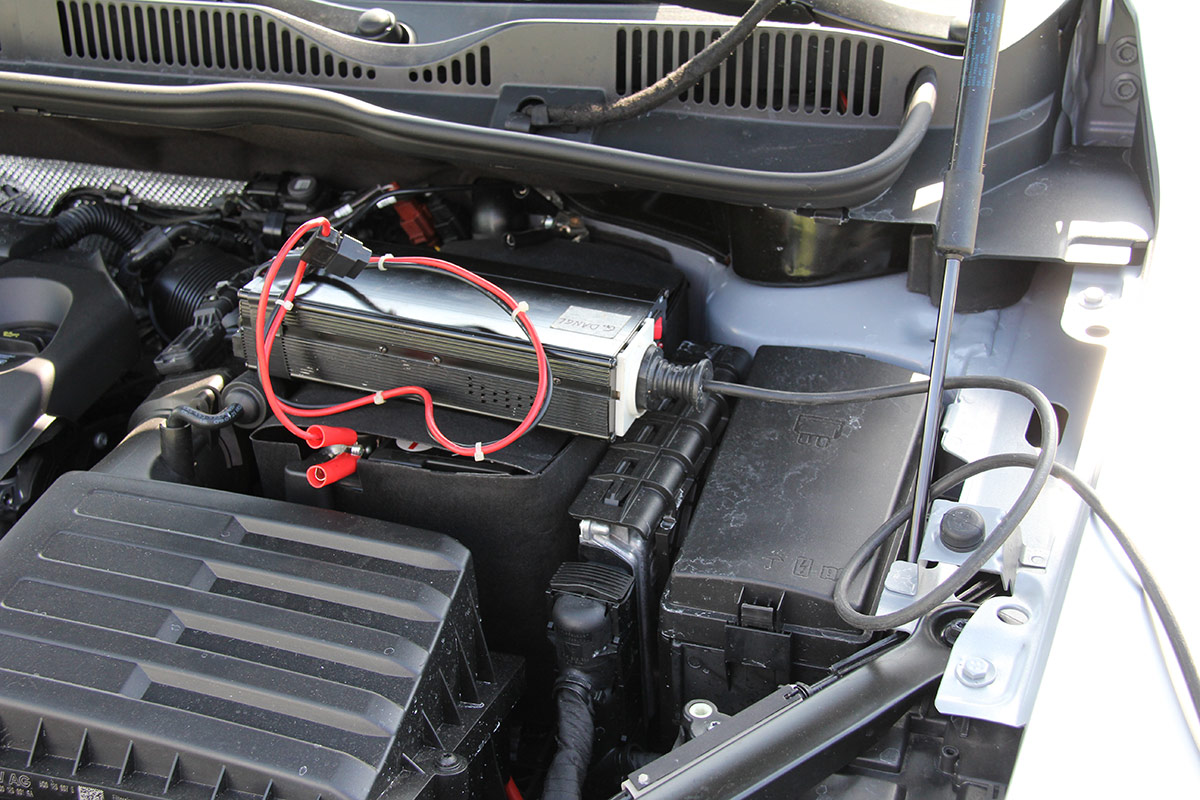
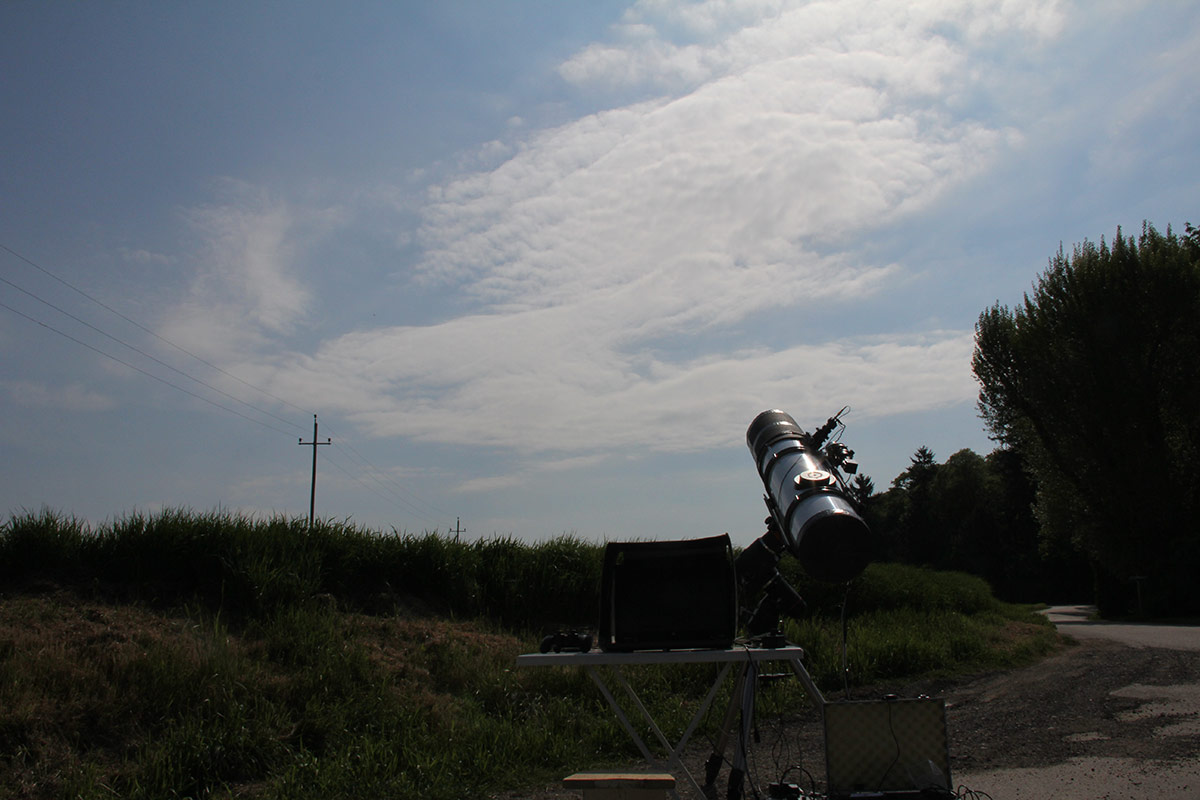
The observation in Ravelsbach on day-sky was then much more difficult than expected. The sky was not completely clear, but was usually traversed by fine cloud structures. The moon with only 3.85% illuminated sickle stood only 22.6 degrees beside the bright sun. Therefore, the moon and star Aldebaran were not recognizable in the day-sky near the sun with the naked eye. Thus, there was the problem that after setting up the EQ6 mount, only the sun could be used as the only reference point in the sky to the basic orientation. For this, sun filters were placed on the viewfinder and the telescope. After positioning on the sun as a reference point, the telescope was controlled to the calculated moon position and the sun filters were removed again. Unfortunately, the narrow crescent moon was also not visible in the relatively large field of view of the search telescope. The sky was so close to the sun just too bright.
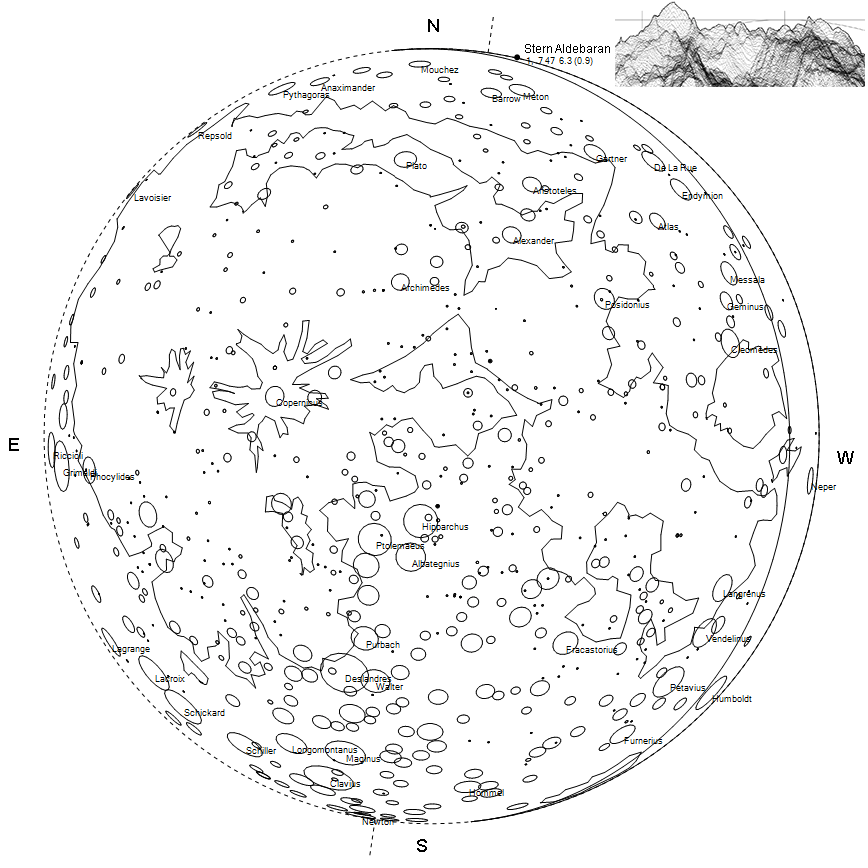
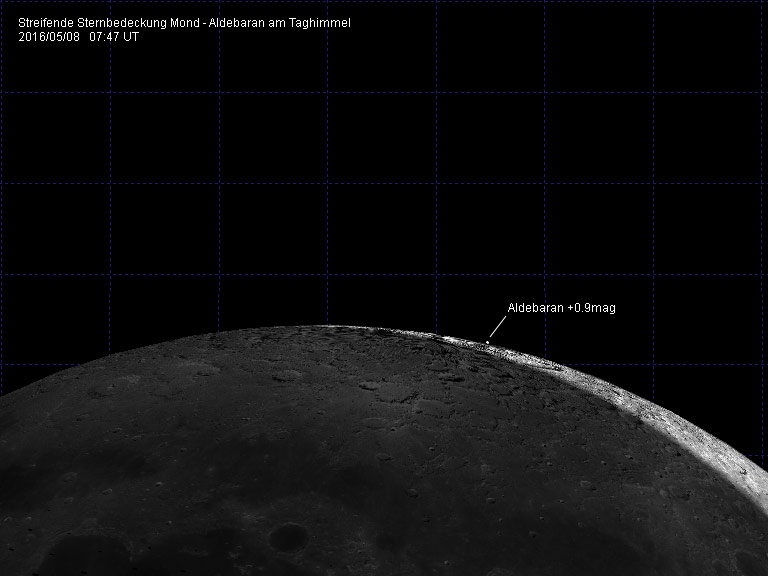
Despite difficult observation conditions, a total of six successive individual coverage events were recorded in Ravelsbach on May 08, 2016 within 76 seconds and recorded on video with GPS time insertion. The time information is assigned to the events according to the system with tolerances of only +/- 20 milliseconds. Due to the extremely difficult recording conditions, a direct and automated video evaluation by software was not possible. Poor contrast and rapid movements caused by strong wind gusts were the main problem. Therefore, nearly 10,000 video single images from this grazing star occultation were manually analyzed. The measurements were sent to the IOTA graze coordinator in Japan, which evaluates all observations made worldwide.
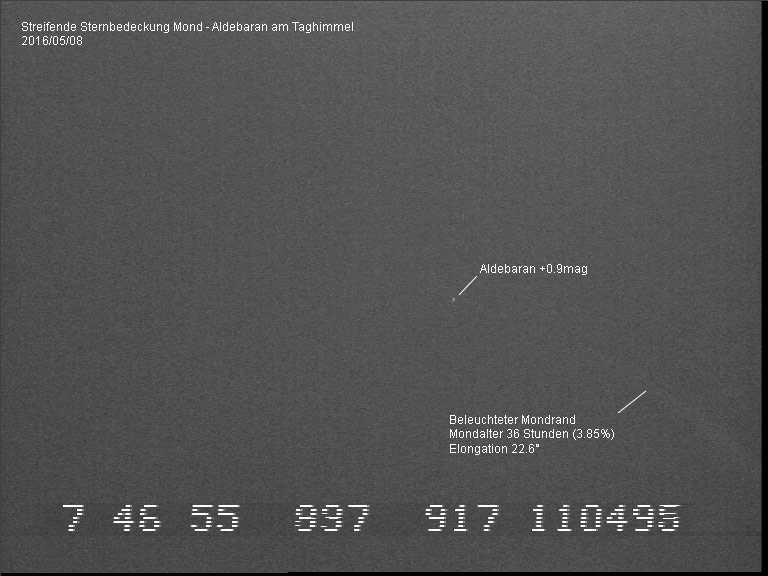
Video of D1/R1
AVI file format - 4.5MBVideo of D2/R2 + D3/R3 + D4/R4
AVI file format - 4.8MBVideo of D5/R5 + D6/R6
AVI file format - 3.2MB
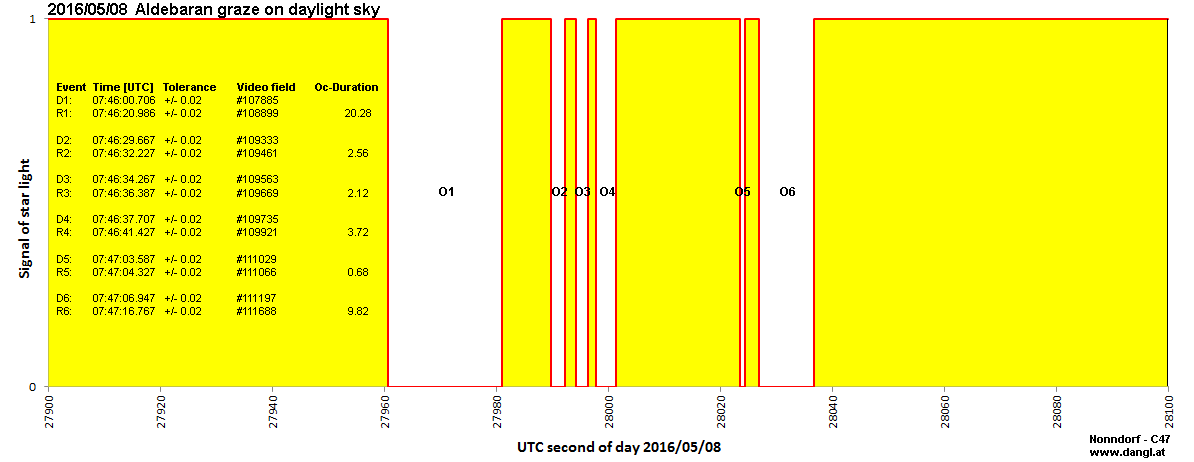
File name : 2016_05_08_dangl_graze.dat
Reduction date : Montag, 27. Juni 2016
Ephemeris : DE430,422 (1600/2250), DE422 (-2999/3000)
Limb basis : LRO Lunar Orbiter Laser Altimeter [LOLA]
O-C basis : limb correction applied
Telescopes:
Aperture Longitude Latitude Alt
# cm o ' " o ' " m
A 25 + 15 50 51.1 +48 33 17.9 268
ref Tel Observer Star No. y m d h m s PhGrMrCeDb O-C limb PA l b AA P D scale
001 A Gerhard Dangl R 692 2016 5 8 7 46 0.71 DB G G 1 -0.02 0.44 349.13 4.55 7.27 357.49 358.04 -7.20 1.070
002 A Gerhard Dangl R 692 2016 5 8 7 46 20.99 RB G G 1 -0.04 0.15 348.47 4.55 7.27 356.82 357.36 -7.25 1.070
003 A Gerhard Dangl R 692 2016 5 8 7 46 29.67 DB G G 1 -0.01 0.03 348.18 4.55 7.27 356.54 357.08 -7.27 1.070
004 A Gerhard Dangl R 692 2016 5 8 7 46 32.23 RB G G 1 -0.01 0.00 348.10 4.55 7.27 356.45 356.99 -7.28 1.070
005 A Gerhard Dangl R 692 2016 5 8 7 46 34.27 DB G G 1 -0.03 0.00 348.03 4.55 7.27 356.39 356.93 -7.28 1.070
006 A Gerhard Dangl R 692 2016 5 8 7 46 36.39 RB G G 1 -0.01 -0.03 347.96 4.55 7.27 356.32 356.86 -7.29 1.070
007 A Gerhard Dangl R 692 2016 5 8 7 46 37.71 DB G G 1 -0.04 -0.01 347.92 4.55 7.27 356.27 356.81 -7.29 1.070
008 A Gerhard Dangl R 692 2016 5 8 7 46 41.43 RB G G 1 -0.01 -0.06 347.80 4.55 7.27 356.15 356.69 -7.30 1.070
009 A Gerhard Dangl R 692 2016 5 8 7 47 3.59 DB G G 1 -0.05 -0.06 347.07 4.55 7.27 355.42 355.96 -7.35 1.070
010 A Gerhard Dangl R 692 2016 5 8 7 47 4.33 RB G G 1 -0.04 -0.07 347.05 4.55 7.27 355.40 355.93 -7.35 1.070
011 A Gerhard Dangl R 692 2016 5 8 7 47 6.95 DB G G 1 -0.05 -0.06 346.96 4.55 7.27 355.31 355.85 -7.36 1.070
012 A Gerhard Dangl R 692 2016 5 8 7 47 16.77 RB G G 1 -0.03 -0.03 346.64 4.55 7.27 354.99 355.52 -7.38 1.070
Mean residual of events involving single stars: -0.03" ±0.01"
Explanation of columns 'PhGrMrCeDb'
Ph - Phase of the event.
1st character D = disappear, R = reappear, B = blink, F = flash, M = Miss
2nd character D = dark limb, B = bright limb, U = in umbra of lunar eclipse
Gr - G if the event is during a graze
Mr - Method of timing and recording. Main types are:
G = video with time insertion, V = video with other time linking
S = visual using a stopwatch, T = visual using a tape recorder, E = eye/ear
Ce - Certainty. 1 = certain, 2 = may be spurious, 3 = most likely spurious
Db - Double star indication - West, East, North, South, Brighter, Fainter

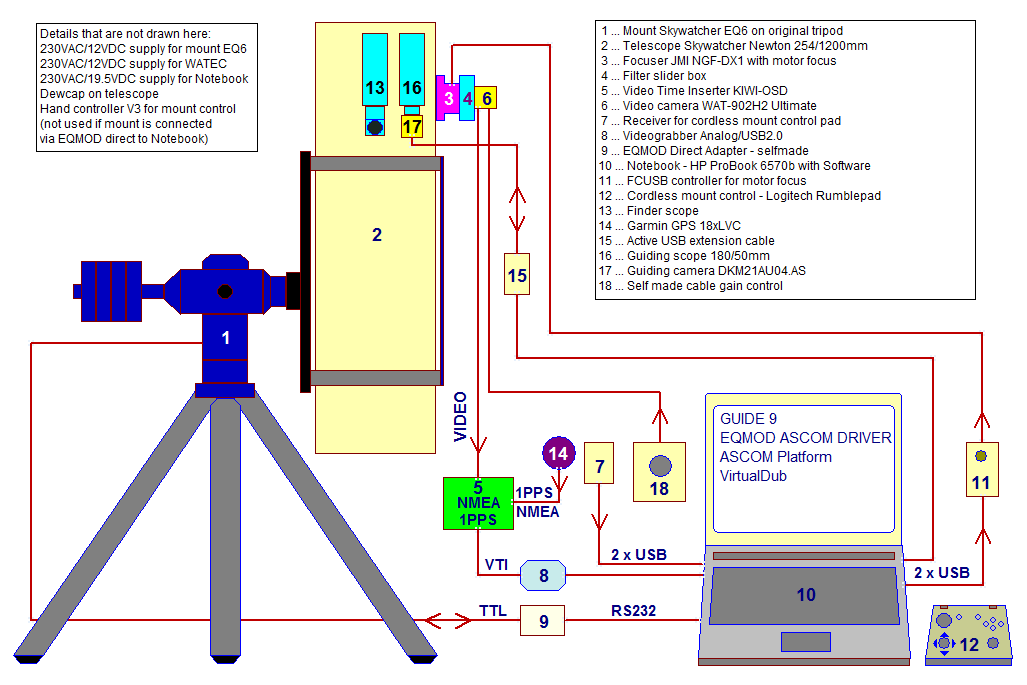
Top of page
August 28, 2017 |
|
Site Home |